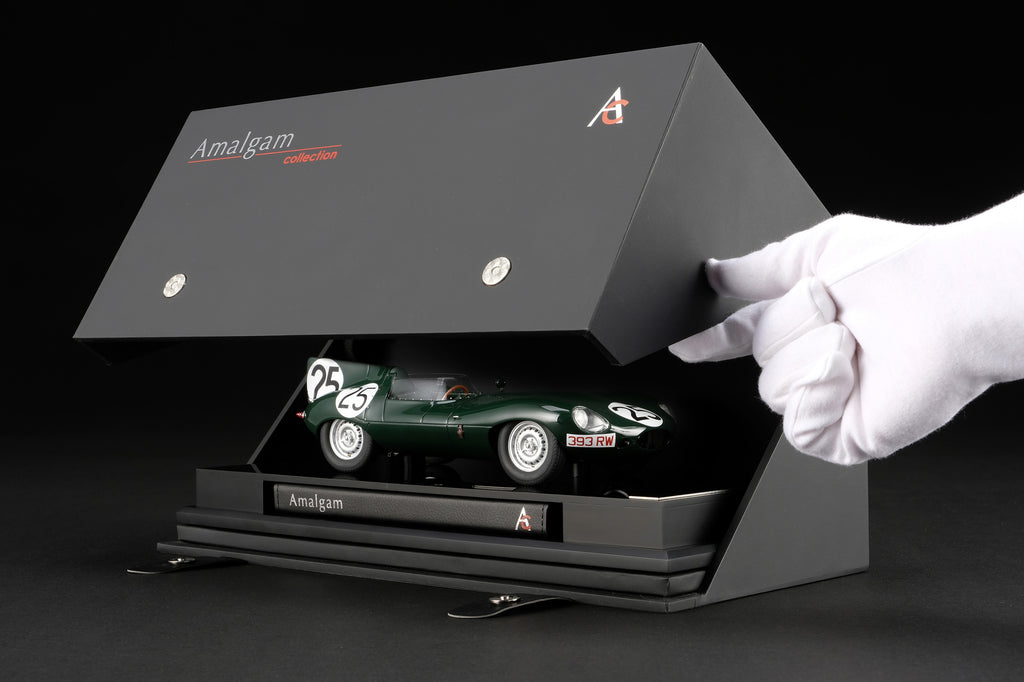
- Amalgam Collection unveils the Jaguar D-type chassis XKD 605 at 1:18 scale
- The stunning model replicates XKD 605 as it raced to a commanding victory in the hands of Duncan Hamilton and Ivor Bueb at the 12 Hours of Reims at Reims-Gueux on the 30th of June 1956
- 800 man-hours were spent developing the model from an extraordinarily accurate digital scan of a notable original D-type
- Models are available to purchase directly from Amalgam and will cost £895 GBP / €1,105 EUR / $1,210 USD
- Media assets can be downloaded here
Bristol, UK – 2nd May 2024: Amalgam Collection today unveils their most recent development at 1:18 scale: the Jaguar D-type chassis XKD 605. The 22 centimetre (8 inch) long model perfectly replicates XKD 605 as raced to a commanding victory by Duncan Hamilton and Ivor Bueb in the 12 Hours of Reims at Reims-Gueux on 30th June 1956. Each model, finished in British racing green, will be handcrafted and assembled in the workshops of Amalgam Collection, using CAD data generated from a scan of an original D-type chassis. This much sought after collectible appeals to all Jaguar and classic motorsport followers, and represents a significant win for Jaguar, Reims being the D-type’s competitive debut.
This smaller 1:18 Jaguar D-type project is a direct continuation of the previous 4000+ hours of intense research and development process Amalgam’s artisans have been through to create the 1:8 scale model, necessitating a further 800 hours of development work. Working from the same CAD data developed following a detailed digital scan of a real chassis, XKD 505/601, Amalgam’s engineers fabricated a pattern for each component of the model. The master patterns were created for each piece of the complex assembly using 3D printing and meticulous hand finishing. Moulds were then taken from each pattern and used to create a small batch of precisely engineered cast components, each one fettled and fitted to make a complete set, before painting, finishing and assembly. The first prototype model only received approval once Amalgam’s expert technical team were fully satisfied with its accuracy of representation. The stunningly detailed and precise 393 RW replica, presented in the iconic British racing green, is the beautiful result.
Sandy Copeman, Founder of Amalgam Collection, commented: “We are truly delighted to have the opportunity to create a reference level model at 1:18 scale of one of the most iconic racing cars of all time. The D-type remains an incredible example of British engineering in the post-war period, not only winning three times at Le Mans but becoming the road-going XKSS and inspiring one of the most famous cars of all time in the legendary E-type.”
Amalgam and Jaguar Land Rover – a partnership of over a decade
The Jaguar D-type 1:18 scale model extends the deep collaboration between Amalgam and Jaguar Land Rover that stretches back over a decade to the early 2010s. The D-type becomes the third Jaguar to be modelled at 1:18 scale by the Bristol-based artisans, behind the E-type (in both Coupe and Spider forms) and the XKSS, and follows on from the 1:8 scale model’s development in 2015. Most recently, Amalgam is working with Jaguar TCS Racing to create bespoke models of the machines currently in use in the ABB FIA Formula E World Championship. Copeman continues: “Jaguar Land Rover’s esteemed place in motorsport history will always be assured – the sheer beauty and speed of their creations deserve to be immortalised. We’re delighted to capture these extraordinary cars at scale for Jaguar and for posterity.”
About Chassis XKD 605
Built in March 1956 as one of 12 Longnose cars, XKD 605 is the penultimate D-type and was allocated to the Jaguar Works racing team. The chassis’ most notable moment came on its competitive debut in Reims, where Duncan Hamilton and Ivor Bueb piloted the car to victory. Bueb and Mike Hawthorn raced XKD 605 at Le Mans the next month but were kept back by persistent misfiring that was eventually traced to a cracked fuel injection pipe. They finished sixth, completing 280 laps, and setting the fastest lap. The car was rebuilt after Le Mans and fitted with a five-speed gearbox. After Jaguar’s withdrawal from racing, the car was supplied as a used car to the Briggs Cunningham team. Painted in their white with blue stripes racing colours, and fitted with a new works 3.8 litre engine, XKD 605 played a part in Walt Hansgen’s second consecutive SCCA Championship for Class C modified sports cars and was driven by Mike Hawthorn and Ivor Bueb to third at Sebring. The car remained in the USA until 1961 and then returned to England, subsequently being re-painted to its original British racing green colour. It was then lent to Italy’s National Motor Museum, where it remained for almost twenty years before its return to the Jaguar factory. One of the most original D-types in preservation, XKD 605 still has the 1956 Le Mans windscreen, passenger seat and door. It proudly wears its original trade plate 393 RW, having been re-registered with the DVLA in 1996, and the race number 25 from its win at Reims.
Models of the 1956 Reims 12 Hours-winning Jaguar D-type at 1:18 scale can be purchased from www.amalgamcollection.com.
----------------------------------------------------------------
High resolution images can be found here >
EDITORS' NOTES:
MEDIA CONTACTS
PR & Media Enquiries: tom.gibsoncommunications@gmail.com, T: (201) 476-0322, Mobile: (201) 264-3646
PR & Media Enquiries: pressandmedia@amalgam.com
Director of Brand and Business Development: Sandy Copeman sandy.copeman@amalgam.com
Business and Sales Enquiries: enquiries@amalgam.com
About Amalgam Collection:
Amalgam’s team of crafts-people are recognised worldwide as makers of the finest hand-made large-scale models. Their work is unique in its attention to detail, with a focus on creating models that truly capture the style and spirit of each car. They have dedicated all their skill and passion to achieving a level of excellence that raises the impact and value of each finished piece far above anything previously created.
For cars they have already modelled at 1:8 in a limited edition, the team at Amalgam offers a tailormade service, customising a model to perfectly match the specification of an owner’s real car. For owners of unique very high value cars, Amalgam Collection offers even bigger 1:5 or 1:4 ‘one-off’ model builds from their UK workshops in Bristol, England. The team will digitally scan the car wherever it is in the world and take up to a thousand pictures of every detail, allowing them to perfectly and accurately replicate everything at scale. Given the significant number of hours required to develop a unique model, the costs are high, so the model is built at a very large scale to maximise the impact and detail, and to deliver the ultimate finished piece.
Amalgam Collection’s design, management and development heart is in England, with extraordinarily skilled and dedicated teams producing the bigger editions in Hungary and China. They are a multinational, multicultural team of craftsmen and women, dedicated to creating the world’s most precise, beautiful and exclusive models. Inspired by the F1 teams and iconic luxury car marques of England and Italy that they serve and partner with, they take huge pride in their mission to perfectly capture the designs, and honour the designers, drivers and creators of the automotive art they love.
HOW AMALGAM MODELS ARE CREATED
- The patterns are created using original CAD from the manufacturer, or extraordinarily accurate digital scans and hundreds of photographs of an original classic car.
- The patterns are used to create silicon rubber moulds that capture every detail.
- Prototyping resin is used to cast the parts from the silicon moulds. Around 20 to 30 parts can be cast from each mould and then a new one must be made.
- Each model is built from thousands of parts: castings, photo-etchings and CNC machined metal components.
- Genuine car paints and manufacturer or archive colour references are used to spray the bodywork.
- It takes between 2,500 and 4,500 hours to develop the tooling for each model.
- It takes between 250 and 450 hours to cast, fit, fettle, paint and build each model.
Every Amalgam Fine Model Car is made entirely by hand from thousands of parts. Detailed original CAD data is supplied by the car's manufacturer or the race team of the car to be modelled. The process of developing each model and creating the master patterns takes between 2,500 and 4,500 hours of skilled work depending on the complexity of the car, with classic cars taking the longest.
In the case of the classic cars an extremely accurate digital scan is made of the car, and hundreds of photographs of all the details of a carefully selected original car are taken, to ensure complete accuracy and adherence to the authentic finishes and materials. Many parts of the model are machined from metal with the major components hand cast from prototyping resin. Each model is individually assembled by a small team of highly skilled model-makers. In total the time taken to machine, cast, hand fettle, paint, polish and assemble each model is between 250 and 450 hours of highly skilled work depending on the complexity of the car.
The finished model is a very precise scale replica of the original car with every detail perfectly and authentically represented at an 8th of the original size. This is modelling elevated to such a high level that it becomes an art form.
Since 1995 Amalgam have been admired and hugely respected by leading designers and engineers in the European automotive industry, as well as F1 designers, drivers and team principals. Amalgam's models appear on the desks of CEOs and presidents of the world's most important car companies. Due to the extreme accuracy and authenticity of Amalgam's creations, made in small limited editions, they are also much sought after by devoted collectors of fine handmade objects across Europe and in the USA.
SCALE GUIDE


